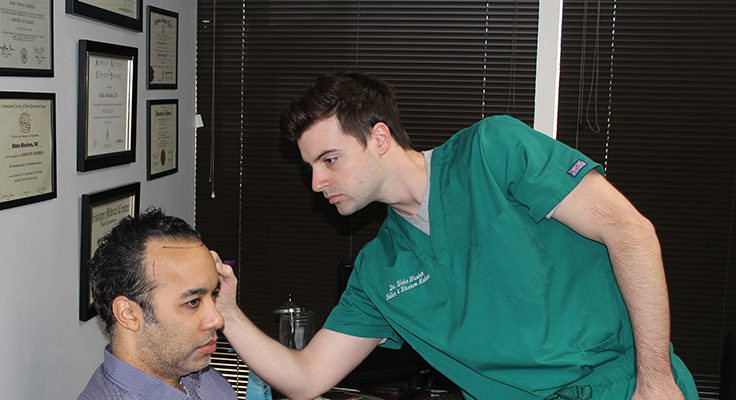Am I a Good Hair Transplant Candidate?

Wondering if you are a candidate for hair transplant surgery? Here are some things to consider:
1) What is Causing My Hair Loss?
While hair loss can be attributed to a number of underlying factors, not all types of hair loss are treatable with surgery. In fact, some types of hair loss – particularly thinning related to underlying immune system problems – may be exacerbated by hair transplant surgery. Thankfully, the vast majority of hair loss patients suffer from genetic male or female pattern hair loss, which can be treated very effectively with surgery. The first step in determining surgical candidacy is identifying what is causing your hair loss. This means your “first stop” on your hair restoration journey should be the office of a medical doctor specializing in the treatment of hair loss.
2) Do I have Enough “Donor”?
As previously described, hair transplant surgery is truly a “moving” procedure; meaning the crux of surgery involves harvesting healthy, permanent follicles from the “safe donor zone” and transplanting them to bald or thinning areas in the “recipient zone” – where they will survive and thrive indefinitely. In order to undergo a successful surgery, you must have enough healthy follicles to take from the donor region. Patients with thinning in the donor or without sufficient donor tissue are, unfortunately, not good candidates for surgery. The only way to determine if you have “the donor” for surgery is to undergo a thorough evaluation with a hair transplant specialist.
3) Are My Goals Realistic?
While modern hair transplant surgery produces excellent, often indistinguishable results, it does have limitations. While most surgical candidates do have robust and healthy donor regions, the number of follicles in this zone is still finite. In other words, there is only so much back there you can take and move to bald regions. Patients with limited amounts of hair loss and thick donor regions may have the luxury of aggressive surgical plans and the ability to allocate a lot of grafts to a small region – therefore achieving the thickest results. For most patients, however, the “demand” of the bald regions in the front often times challenges the “supply” of donor follicles in the back. This means patients must understand that there are limitations to what can be done. While all patients want the low, flat, perfect hairline of their favorite Hollywood actor, it may not be possible – or not advisable. It may be better to begin with a more conservative, natural approach which will “age” well and leave donor follicles available for surgery in the future. Are you okay with a very thick and natural, but slightly higher and more “mature” hairline? Do you understand using half the available donor to recreate the “high school hairline” that likely will not look natural and create problems “down the road” isn’t the best plan? If so, your goals are realistic and you should be pleased with the results.
4) Am I okay with the Prospect of Multiple Surgeries?
The vast majority of patients want a “one and done” approach to their hair restoration. No one likes the thought of undergoing multiple surgical procedures, but it is often the reality. There is only so much that can be taken from the donor safely in one sitting. And while modern “mega session” techniques allow us to safely move upwards of 3,000 – 4,000 grafts in a single sitting, this is only possible in patients with excellent donor zones. Like it or not, the average patient simply does not have the donor “characteristics” to do a session this large (safely) in one sitting. In fact, the average patient can probably do around 2,000 – 2,500 grafts in one day. To provide some perspective, a patient with advanced hair loss likely needs around 5,000 – 6,000 follicular unit grafts to achieve acceptable coverage from “front to back.” What this means is that patients who want full coverage at some point will likely need at least two procedures. Fortunately, the majority of patients seek surgical treatment before this point; and for these patients, 2,000 – 2,500 grafts is more than sufficient. Furthermore, a surgery this size focused on the most cosmetically visible regions of the scalp (the front and middle) still makes an enormous difference for patients with advanced loss. Even with thinning left in the less visible “back,” of the scalp, many patients report feeling satisfied and do not see the need to address the back once the front and mid-scalp are restored. However, patients with advanced or progressive hair loss must be aware that they may want more surgery at a later date and must accept that a “one and done” approach to surgery is sometimes not realistic.
5) Am I Ready to Make a Positive Change?
Despite some of the stern topics discussed above, hair transplant surgery can be a life-changing experience for patients. Loss of hair represents a loss off identity, and many patients feel depressed, reclusive, and dejected before they restore their hair. Thankfully the results of a modern, properly performed hair transplant are extremely natural, and patients are actually able to restore this sense of self. It can be an emotional journey and taking the “leap” is sometimes difficult; however, those who are ready to make a positive change and address this issue “head on” (no pun intended) often make great candidates and even better success stories.





